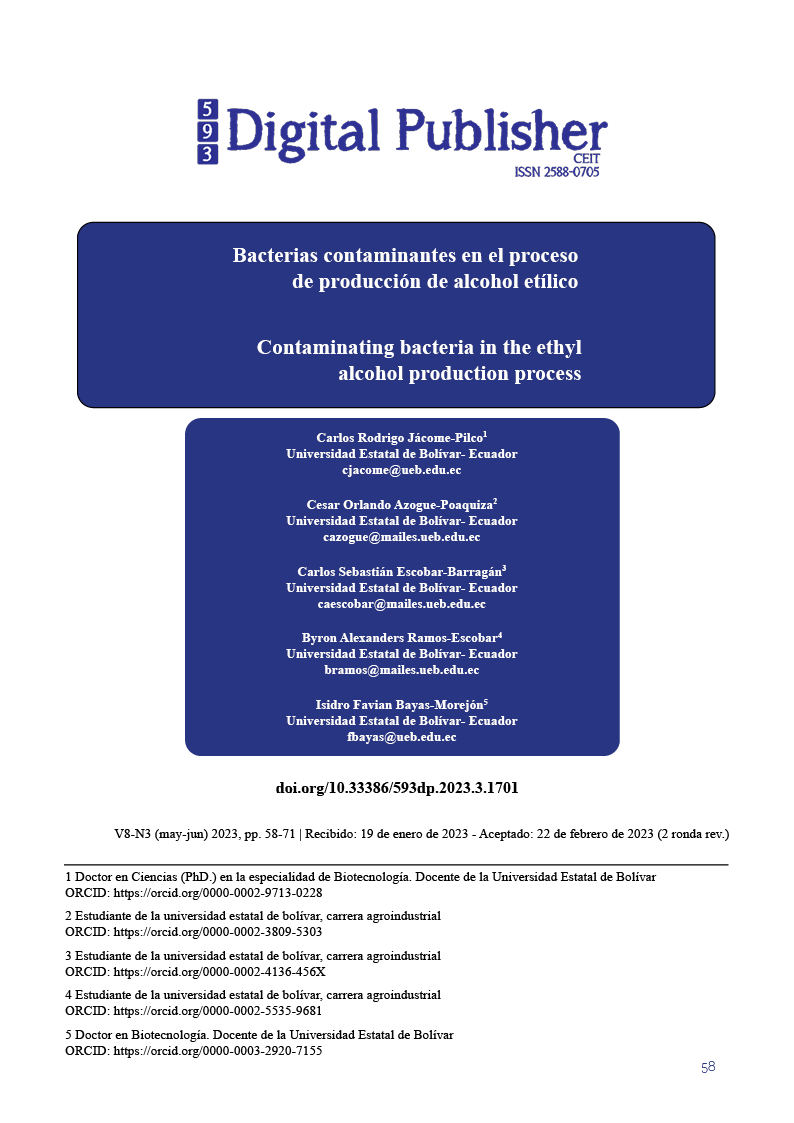Contaminating bacteria in the ethyl alcohol production process
Main Article Content
Abstract
In recent years, interest has increased in the interactions and population dynamics between lactic acid bacteria and yeasts in the fermentation of alcoholic beverages, which influence the production of ethanol and volatile compounds depending on the quality of alcoholic beverages. Most of the research has focused on these interactions in fermentation processes, for example red, white and other fermented wines. A wide variety of microorganisms have been found to be present in the enzymatic processes of tehuino and mezcal. In this study, 17 lactic acid bacteria were analyzed for cell growth and resistance to various ethanol concentrations and osmolarity. The selected bacteria were then used in various combinations of bacterial yeast to assess the growth of two different species using CFU colony forming units.
Downloads
Article Details

This work is licensed under a Creative Commons Attribution-NonCommercial-ShareAlike 4.0 International License.
1. Derechos de autor
Las obras que se publican en 593 Digital Publisher CEIT están sujetas a los siguientes términos:
1.1. 593 Digital Publisher CEIT, conserva los derechos patrimoniales (copyright) de las obras publicadas, favorece y permite la reutilización de las mismas bajo la licencia Licencia Creative Commons 4.0 de Reconocimiento-NoComercial-CompartirIgual 4.0, por lo cual se pueden copiar, usar, difundir, transmitir y exponer públicamente, siempre que:
1.1.a. Se cite la autoría y fuente original de su publicación (revista, editorial, URL).
1.1.b. No se usen para fines comerciales u onerosos.
1.1.c. Se mencione la existencia y especificaciones de esta licencia de uso.
References
Aguilar, Q. T. (2017). Industrial Microbiology: Microorganisms of Industrial Interest. Ingeniería e Investigación Vol. 31 No. 3, 56-65.
Antón, M. (2018). “Breaking Frontiers and Barriers in Engineering: Education, Research and Practice”. LACCET, 21-23.
Beasley, S. (2019). Lactic acid bacteria isolated from canine faeces. Journal of applied microbiology,. Barcelona: Editorial Marcombo.
Bely, M. (2019). Impact of mixed Torulaspora delbrueckii–Saccharomyces cerevisiae culture on high-sugar fermentation. International journal of food microbiology. Oklahoma: Editorial Enterprises.
Bermejo, F. O. (2019). Saccharomyces cerevisiae–Oenococcus oeni interactions in wine: current knowledge and perspectives. Prospect. Vol. 8, No. 2, 37-43.
Bonmatí, A. F. (2018). Enhancing the Sweetness of Yoghurt through Metabolic Remodeling of Carbohydrate Metabolism in Streptococcus thermophilus and Lactobacillus delbrueckii subsp bulgaricus. Applied and environmental microbiology. Water Science and Technology, 109-116.
Cañas, P. (20017). Influence of inoculation time of an autochthonous selected malolactic bacterium on volatile and sensory profile of Tempranillo and Merlot wines. Madrid: Editorial Mundi.
Cengel, Y. (2015). Lactobacillus sicerae sp. nov., a lactic acid bacterium isolated from Spanish natural cider. México D.F.: Editorial Mc Graw Hill.
Chambers, P. (18 de Noviembre de 2019). Pretorius, Fermenting knowledge: the history of winemaking, science and yeast research. EMBO reports, 914 - 920. Recuperado el 25 de Enero de 2014, de Surface meteorology and Solar Energy: https://eosweb.larc.nasa.gov/sse/
Ciani, M. (2016). interactions in inoculated wine fermentation. Frontiers in Microbiology. Rio de Janeiro: Editorial Interciencia.
Comitini, E. (2018). Interactions between Saccharomyces cerevisiae and malolactic bacteria: preliminary characterization of a yeast proteinaceous compound (s) active against . Revista Tecnológica Espol-RTE,Vol.23, N. 1, 135-142.
Cornejo, C., & Wilkie, A. (2017). The contribution of indigenous non-Saccharomyces wine yeast to improved aromatic quality of Cabernet Sauvignon wines by spontaneous fermentation. Revista Tecnológica Espol-RTE,Vol.23, N. 1, 135-142.
Diaz, F., & Montalvo, J. (2017). Antagonistic interaction between yeasts and lactic acid bacteria of oenological relevance: Partial characterization of inhibitory compounds . Energética Vol. XXIV, No. 1, 24 - 35.
Dihigo, L. (2019). Simultaneous and successive inoculations of yeasts and lactic acid bacteria on the fermentation of an unsulfited Tannat grape must. Revista Computarizada De Producción Porcina, 12 - 16.
Domínguez, P. (2016). Biochemical transformations produced by malolactic fermentation, in Wine chemistry and biochemistry. Instituto de Investigaciones Porcinas., 18 - 20.
Duarte, W. (2018). Effect of Co‐Inoculation of Saccharomyces cerevisiae and Lactobacillus fermentum on the Quality of the Distilled Sugar Cane Beverage Cachaça. Madrid: Editorial Mundi-Prensa.
Fernández, J. (2019). Interaction of Saccharomyces cerevisiae and Lactococcus lactis in the fermentation and quality of artisanal cachaça. Madrid: Editorial Mundi-Prensa.
Flotats, X. (2018). Culture-independent analysis of lactic acid bacteria diversity associated . SUIS N° 72, 23 - 27.
García, G. (2016). Yeast communities associated with artisanal mezcal fermentations from Agave salmiana. Madrid: Editorial Mundi-Prensa.
Gomera, L. (2018). Fermentative capabilities and volatile compounds produced by Kloeckera/Hanseniaspora and Saccharomyces yeast strains in pure and mixed cultures. Madrid: Editorial Bellisco.
Houdkova, L. (2016). Enological properties in wild and commercial Saccharomyces cerevisiae yeasts: relationship with competition during alcoholic fermentation. Thermal Science Vol. 12, 27-33.
Incropera, P. (2015). The effect of Debina grapevine indigenous yeast strains of Metschnikowia and Saccharomyces on wine flavour. New York: Editorial John Wiley & Sons.
Ivey, M. (2018). Microbial interactions in food fermentations. Annual review of food science and technology,. México D.F.: Editorial Thomson.
Jutglar, L. (2017). Comitini, and M. Ciani, Influence of vintage and selected starter on Torulaspora delbrueckii/Saccharomyces cerevisiae sequential fermentation. . Barcelona: Editorial Ceac.
Kleerebezem, M. (2018). Quorum sensing control of lantibiotic production; nisin and subtilin autoregulate their own biosynthesis. Brasilia: Editorial Cirad.
Kleinbach, M. (2016). Interactions between Kluyveromyces marxianus and Saccharomyces cerevisiae in tequila must type medium fermentation. . Chicago: Editorial Thomson.
Kreith, F. (2017). Importance of acetic acid bacteria in food industry. México D.F.: Editorial Thomson.
Linscott, B. (2017). Yeast–yeast interactions revealed by aromatic profile analysis of Sauvignon Blanc wine fermented by single or co-culture of non-Saccharomyces and Saccharomyces yeasts. . Oklahoma: Editorial Enterprises.
Lonvaud, F. (2018). Lactic acid bacteria in the quality improvement and depreciation of wine, in Lactic Acid Bacteria: Genetics, Metabolism and Applications. México D.F.: Editorial Mc Graw Hill.
Madrid, A. (2018). Oenococcus alcoholitolerans sp. nov., a lactic acid bacteria isolated from cachaça and ethanol fermentation processes. Madrid: Editorial Mundi.
Manoni, A. P. (2018). Sequential inoculation versus co-inoculation in Cabernet Franc wine fermentation. Food Science and Technology International. African Journal of Biotechnology Vol. 8 (2), 116-125,.
Manrique, A. (2017). Evaluation of technological effects of yeast–bacterial co-inoculation in red table wine production. México D.F.: Editorial Oxoford.
Mantilla, J., Duque, C., & Galeano, C. (2017). Quantitative study of interactions between Saccharomyces cerevisiae and Oenococcus oeni strains. Revista Ingeniería e Investigación Vol. 27 No.3, 133-142.
Mills, A. (2016). The inhibitory activity of wine yeast starters on malolactic bacteria. Annals of microbiology. Editorial Irwin: Editorial Irwin.
Morgan, S. (2017). Sulfur dioxide addition at crush alters Saccharomyces cerevisiae strain composition in spontaneous fermentations at two Canadian wineries. Madrid: Editorial Bellisco.
Pan, W. (2018). Kinetics of sugars, organic acids and acetaldehyde during simultaneous yeastbacterial fermentations of white wine at different pH values. Madrid: Editorial Mundi.
Panesso, F. C. (2018). Redox interactions between Saccharomyces cerevisiae and Saccharomyces uvarum in mixed culture under enological conditions. Scientia et Technica Año XVII, No 47., 35 - 40.
Piskur, J. (2018). How did Saccharomyces evolve to become a good brewer? . Barcelona: Editorial Reverté.
Pogglo, D. F. (2019). Bacterial communication and group behavior. LivestockResearchfor Rural Development, 9.
Prado, N. (2017). Volatile compounds generation during different stages of the Tequila production process. Barcelona: Editorial Reverté.
Rossouw, D. (2017). The impact of co-inoculation with Oenococcus oeni on the trancriptome of Saccharomyces cerevisiae and on the flavour-active metabolite profiles during fermentation in synthetic must. Food microbiology. Madrid: Editorial Mundi.
Rufes, P. (2018). Differential roles of the two-component peptides of lactocin 705 in antimicrobial activity. . Barcelona: Editorial Marcombo.
Rul, F. (2018). How microbes communicate in food: a review of signaling molecules and their impact on food quality. Brasilia: Editorial Cirad.
Sardon, J. (2013). Alteration of the growth rate and lag time of Leuconostoc . Madrid: Editorial Paraninfo.
Sorensen, B. (2017). Effect of the fatty acid composition of acclimated oenological Lactobacillus plantarum on the resistance to ethanol. Burlington: Editorial Elsevier.
Tiukova, I. (2017). Interaction of Lactobacillus vini with the ethanolproducing yeasts Dekkera bruxellensis and Saccharomyces cerevisiae. Chicago: Editorial Thomson.
Tower, M. W. (2010). Simultaneous inoculation of yeasts and lactic acid bacteria: Effects on fermentation dynamics and chemical composition of Negroamaro wine. Inc.Snohomish, 53.
Vélez, C., Pinedo, C., Viramontes, O., Ortega, C., & Melgoza, A. (2008). Performance evaluation of Pichia kluyveri, Kluyveromyces marxianus and Saccharomyces cerevisiae in industrial tequila fermentation. Revista TECNOCIENCIA Chihuahua, Vol. 11, No. 2, 37 - 42.
Viquez, J. (2019). Fermentation of cow milk and/or pea milk mixtures by different starter cultures: Physico-chemical and sensorial properties. Revista ECAG Informa No. 50, 22 - 27.
Yuan, Y. (2017). Directional isolation of ethanol-
tolerant acetic acid bacteria from industrial fermented . Burlington: Editorial Elsevier.






